In an experiment, a student cut a transverse section of young stem of a plant which he has taken from his school garden.
After observing it under the microscope how would he ascertain whether it is a monocot stem or a dicot stem?
With the help of bulliform cells.
With the help of casparian strips.
With the help of vascular bundles.
With the help of stomatal apparatus.
Correct Answer :
C. With the help of vascular bundles.
By observing the arrangements of vascular bundles, the student will discover the nature of stem. If the vascular bundles are arranged in a ring then it is a dicot stem and if the vascular bundles are scattered, then it is a monocot stem.
Related Questions
Xylem functions as a conducting tissue for water and minerals from _________to the ______and__________.
roots, stems, leaves
stems, roots, leaves
leaves, stems, roots
leaves, stems, leaves
Match column-I with column-II and choose the correct option.
| A. Spring wood or | I. Lighter in colour early wood |
|---|---|
| B. Autumn wood or | II. High density late wood |
| .. | III. Low density |
| .. | IV. Darker in colour |
| .. | V. Larger number of xylem elements |
| .. | VI. Vessels with wider cavity |
| .. | VII. Lesser number of xylem elements |
| .. | VIII. Vessels with small cavity |
Which of the following combination is correct ?
A II, IV, VII, VIII; B I, III, V, VI
A I, II, VII, VIII; B III, IV, V, VI
A I, III, V, VI; B II, IV, VII, VIII
A I, III, VII, VIII; B II, IV, V, VI
Read the following statements and answer the question.
- It has a sclerenchymatous hypodermis, a large number of scattered vascular bundles and a large parenchymatous ground tissue.
- Vascular bundles are conjoint and closed.
- Peripheral vascular bundles are generally smaller than the centrally located ones.
- Phloem parenchyma is absent, and water- containing cavities are present within the vascular bundles.
Which plant anatomy is being described by the above statements?
Dicotyledonous root
Monocotyledonous root
Dicotyledonous stem
Monocotyledonous stem
A narrow layer of thin walled cells found between phloem/ bark and wood of a dicot is
cork cambium
vascular cambium
endodermis
both (a) & (c)
Some vascular bundles are described as open because these
are surrounded by pericycle but not endodermis.
are capable of producing secondary xylem and phloem.
possess conjunctive tissue between xylem and phloem.
are not surrounded by pericycle.
T.S. of dicot stem is given below, certain parts have been marked by alphabets (A I). Choose the option which shows their correct labelling.

A Epidermis, B Epidermal hair, C Parenchyma, D Starch sheath, E Hypodermis (collenchyma), F Vascular bundle, G Bundle cap, H Medulla or pith, I Medullary rays
A Epidermal hair, B Epidermis, C Hypodermis (collenchyma), D Parenchyma, E Endoderm is (Starch Sheath), F Pericycle, G Vascular bundle, H Medullary rays, I Medulla or pith
A Epidermal hair, B Epidermis, C Hypodermis (collenchyma), D Starch sheath, E Parenchyma, F Vascular bundle, G Bundle cap, H Medulla or pith, I Medullary rays
A Epidermal hair, B Epidermis, C Parenchyma, D Hypodermis (collenchyma), E Starch sheath, F Vascular bundle, G Bundle cap, H Medulla or pith, I Medullary rays
Which of the following statement(s) is/are not correct?
- Cork cambium is also called phellogen.
- Cork is also called phellem.
- Secondary cortex is also called periderm.
- Cork cambium, cork and secondary cortex are collectively called phelloderm.
(iii) and (iv)
(i) and (ii)
(ii) and (iii)
(ii) and (iv)
In the given figure of phloem tissue, identify the marked part (A, B and C) which help in maintaining the pressure gradient
in the sieve tubes.
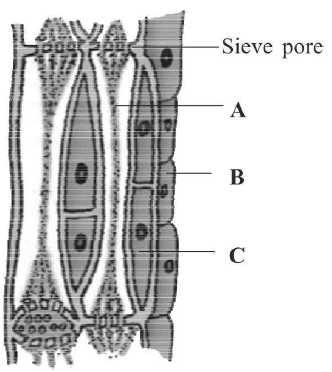
A
B
C
None of the above
Which of the following statements are correct ?
- Xylem transports water and minerals.
- Gymnosperms lack sieve tubes and companion cells in phloem.
- The first formed primary xylem is called metaxylem.
- Phloem fibres (bast fibres) are made up of collenchymatous cells.
(i) and (iii)
(i) and (ii)
(iii) and (iv)
(i) and (iv)
Which of the following process helps the trichomes in preventing water loss?
Where companion cells helps in maintaining the pressure gradient in the sieve tubes.
Where plants absorb water through the roots and then give off water vapor through pores in their leaves.
Where activity of cork cambium builds pressure on the remaining layers peripheral to phellogen and ultimately these layers dies and slough off.
None of the above
Identify A, B and C in the given figure of shoot apical meristem
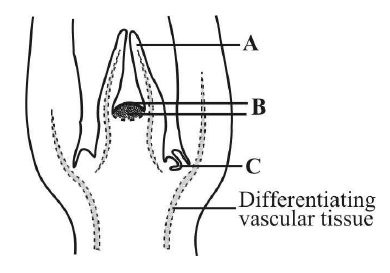
A Leaf primordium, B Shoot apical meristem, C Axillary bud
A Leaf primordium, B Shoot apical meristem, C Apical bud
A Root hair primordium, B Root apical meristem, C Axillary bud
A Root hair primordium, B Root apical meristem, C Terminal bud
Which of the following are present in monocot root ?
conjoint, collateral, open polyarch vascular bundle.
exodermis, endarch, tetrarch closed vascular bundles.
suberized exodermis, casparian strip, passage cells, cambium.
suberized exodermis, polyarch xylem, pith.
Cork cambium and vascular cambium are
the parts of secondary xylem and phloem.
the parts of pericycle.
lateral meristems.
apical meristems.
Sclerenchyma usually___________and_____________ protoplasts.
live, without
dead, with
live, with
dead, without
Read the following statements and answer the question.
- Cambium is very active and produces a large number of xylary elements having vessels with wider cavities.
- It is also called early wood.
- It is lighter in colour and has lower density.
Which type of wood is described by the above statements?
Sap wood
Heart wood
Spring wood
Autumn wood
Which meristem helps in increasing girth?
Lateral meristem
Intercalary meristem
Primary meristem
Apical meristem
Identify the types of simple tissue indicated by A, B, C and D and their function.
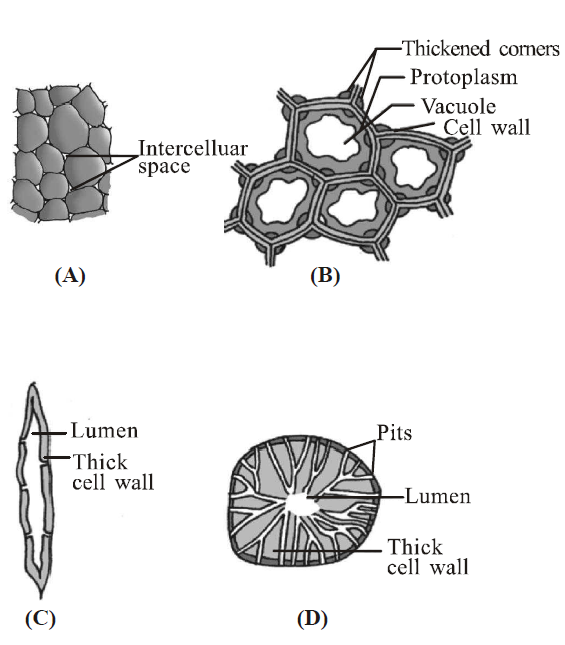
A Parenchyma, Photosynthesis, Storage and Secretion.
B Sclerenchyma Scleriods; Transport food material
C Collenchyma; Provides mechanical support to organs.
D Sclerenchyma Fibres; Provide Mechanical support to the growing parts of the plant such as young stem and petiole of a leaf.
A student was given a tissue to observe under the microscope. He observes the tissue and concludes that the tissue is a type of simple plant tissue and provides mechanical support to young stem and petiole of leaf.
Identify the tissue.
Parenchyma
Collenchyma
Sclerenchyma
Xylem parenchyma
Gymnosperms are also called soft wood spermatophytes because they lack
cambium
phloem fibres
thick-walled tracheids
xylem fibres
T.S. of dicot leaf passing through the midrib is given below. Certain parts have been marked by alphabets (A to H). Choose the option showing their correct labelling.

A Epidermis, B Spongy mesophyll, C Palisade mesophyll, D Stomata, E Guard cells, F Phloem, G Metaxylem, H Protoxylem
A Epidermis, B Palisade mesophyll, C Spongy mesophyll, D Sub-stomatal cavity, E Stoma, F Phloem, G Xylem, H Bundle sheath
A Epidermis, B Palisade mesophyll, C Spongy mesophyll, D Stomata, E Guard cells, F Epidermis, G Xylem, H Phloem
A Epidermis, C Palisade mesophyll, C Spongy mesophyll, D Stomata, E Guard cells, F Phloem, G Metaxylem, H Protoxylem
Cells of permanent tissues are specialized
functionally.
only structurally.
both structurally and functionally.
for mitosis.
Tissue(s) present in an annual ring is/are
secondary xylem and phloem.
primary xylem and phloem.
secondary xylem only.
primary phloem and secondary xylem.
Which of following helps bamboo and grasses to elongate ?
Apical meristems
Lateral meristems
Secondary meristems
Intercalary meristems
Cork is formed from
phellogen
vascular cambium
phloem
xylem
A common structural feature of vessel elements and sieve tube elements are
pores on lateral walls.
presence of p-protein.
enucleate condition.
thick secondary walls.
T.S. of monocot leaf is given below, certain parts have been marked by alphabets (A G). Which one is the option showing there correct labelling?
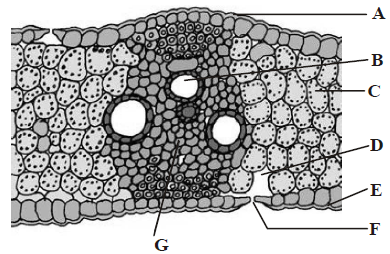
A Adaxial epidermis, B Xylem, C Mesophyll, D Sub-stomatal cavity, E Abaxial epidermis, F Stoma, G Phloem
A Adaxial epidermis, B Abaxial epidermis, C Xylem, D Sub-stomatal cavity, E Stoma, F Mesophyll, G Phloem
A Adaxial epidermis, B Phloem, C Mesophyll, D Sub-stomatal cavity, E Abaxial epidermis, F Xylem, G Stoma
A Adaxial epidermis, B Xylem, C Stoma, D Substomatal cavity, E Abaxial epidermis, F Phloem, G Mesophyll
Lignin is the important constituent in the cell wall of
phloem
parenchyma
xylem
cambium
Which one of the followings option shows the correct labelling of the parts marked as A, B, C and D in the given figure a lenticel?
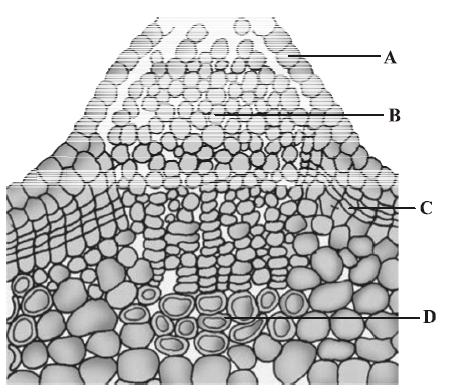
A Epidermis, B Secondary cortex, C Cork cambium, D Cork
A Pore, B Cork cambium, C Secondary cortex, D Cork
A Pore, B Cork, C Complimentary cells, D Cork cambium
A Epidermis, B Complimentary cells, C Cork cambium, D Secondary cortex
Apical, intercalary and lateral meristems are differentiated on the basis of
origin
function
position
development
Match the terms given in column I with their features given in column II and choose the correct option.
| Column-I | Column-II |
|---|---|
| (Terms) | (Features) |
| A. Fibres | (i) Cells are living and thin walled with cellulosic cell wall, store food materials in the form of starch or fat |
| B. Sclereids | (ii) Main water conductive cells of the pteridophytes and the gymnosperms |
| C. Tracheids | (iii) Thick walled, elongated and pointed cells, generally occurring in groups |
| D. Vessels | (iv) Long cylindrical tube like structure and cells are devoid of protoplasm. Characteristic feature of angiosperms |
| E. Xylem parenchyma | (v) Reduced form of sclerenchyma cells with highly thickened lignified cellular walls that form small bundles of durable layers of tissue in most plants. |
A - (i), B - (ii), C - (iii), D - (iv), E - (v)
A - (iii), B - (v), C - (ii), D - (iv), E - (i)
A - (iii), B - (i), C - (v), D - (ii), E - (iv)
A - (v), B - (iv), C - (iii), D - (i), E - (ii)
